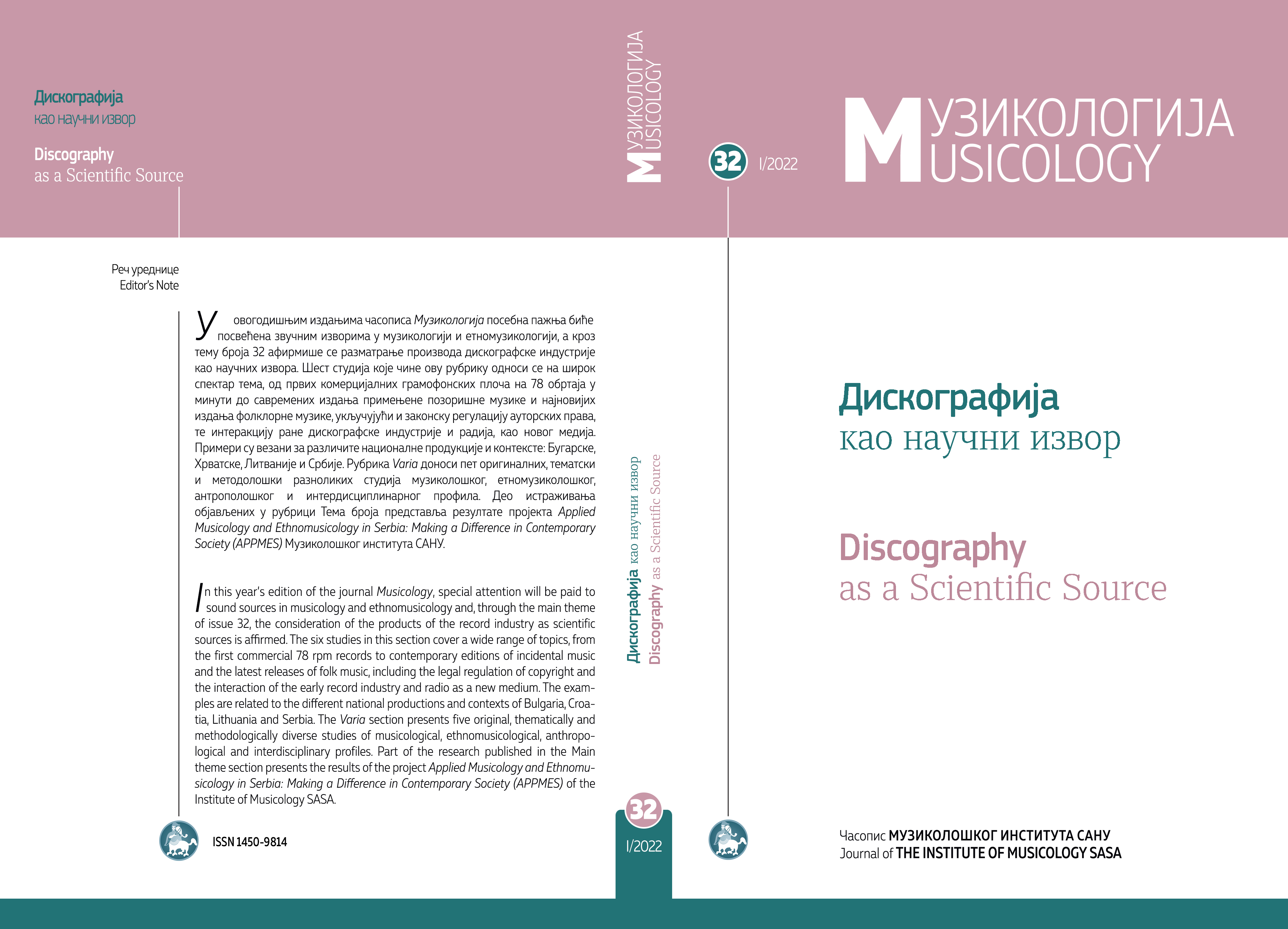Two Faces of Mystification: The Representation of the Holocaust in Arnold Schoenberg's A Survivor from Warsaw and Steve Reich's Different Trains
Два лица мистификације: представљање Холокауста у делима A Survivor from Warsaw Арнолда Шенберга и Different Trains Стива Рајша
Keywords:
Holocaust, Arnold Schoenberg, Steve Reich, art music, politics of memoryAbstract
The paper discusses the approaches of different media to Holocaust (re)presentation, with special reference to art music in the 20th century. Following the classification proposed by Michael Rothberg on two possible perspectives for representing the Holocaust: realistic and anti-realist (2000), we analyse two compositions: Arnold Schoenberg’s A Survivor From Warsaw (1947) and Steve Reich’s Different Trains (1988). The aim of the paper is to point out how artistic music reflects and participates in the dominant historical and contemporary discourses of Holocaust representation, especially the discourses of “heroism” and “non-representability”.
References
Adorno, Theodor (2004) Negative Dialectics, Rautledge, New York, (orig. 1966).
Adorno, Theodor (1977) Noten Zur Literatur, Frankfurt am Main: Suhrkamp Verlag.
Arendt, Hannah (1950) „Social Science Techniques and the Study od Concentration Camps”, Jewish Social Studies 12 (1): 49–64.
Arnold, Ben (1991) „Art Music and The Holocaust”, Holocaust and Genocide Studies 6 (4): 335–349.
Bauer, Yehuda (1989) „Against Mystification: The Holocaust as a Historical Phenomenon”. In Michael R. Marrus (ed.), The Nazi Holocaust, Part 1: Perspectives on the Holocaust, Munich: K. G. Saur, 98–117.
Beirens, Maarten (2019) „Different Tracks: Narrative Sequence, Harmonic (Dis)continuity, and Structural Organization in Steve Reich’s Different Trains and The Cave”. In Gopinath, Sumanth & Ap Siôn, Pwyll (eds.), Rethinking Reich, Oxford University Press, 75–92.
Casey, Celia (2019) „From World War II to the ‘War on Terror’: An Examination of Steve Reich’s ‘Docu-Music’ Approach in WTC 9/ 11”. In Gopinath, Sumanth & Ap Siôn, Pwyll (eds.), Rethinking Reich, Oxford University Press, 159–176.
Copley, Jessica (2010) Modes of Representing The Holocaust: A Discussion of the use of Animation in Art Spiegelman’s ‘Maus’ and Orly Yadin and Sylvie Bringas’s ‘Silence’, Opticon 1826 9.
Cumming, Naomi (1997) „The Horrors of Identification: Reich's ‘Different Trains’”, Perspectives of New Music 35 (1), 129–152.
Eagelstone, Robert (2004) The Holocaust and The Postmodern, Oxford, UK: Oxford University Press.
Еrll, Astrid (2008) „Cultural Memory Studies: An Introduction”. In Astrid Erll and Ansgar Nünning (eds.) Cultural Memory Studies: An International and Interdisciplinary Handbook, Berlin, New York: Walter de Gruyter, 1–15.
Fox, Chirstopher (1990) „Steve Reich’s ‘Different Trains’”, Tempo 3 (172), 2–8.
Gilbert, Shirli (2005) Music in the Holocaust: Confronting Life in the Nazi Ghettos and Camps, Oxford, UK: Oxford University Press.
Gilbert, Shirli (2008) „Buried Monuments: Yiddish Songs and Holocaust Memory”, History Workshop Journal 66: 107–128.
Hilberg, Raul (1996) The Politics of Memory: The Journey of a Holocaust Historian, Chicago: Ivan R. Dee.
Insdorf, A. (2003) Indelible Shadows: Film and the Holocaust Third Edition, Cambridge, New York: Cambridge University Press.
Levi, Primo (1989) The Drowned and the Saved, New York, NY: Vintage International.
Listoe, Daniel B. (2006) „Seeing Nothing: Allegory and the Holocaust’s Absent Dead”, SubStance 110/35 (2): 51–70.
Marshman, Sophia (2000) „From the Margins to the Mainstream: Representations of the Holocaust in Popular Culture”, eSharp 6 (1).
Potter, Keith (2002) Four Musical Minimalists: La Monte Young, Terry Riley, Steve Reich, Philip Glass, Cambridge, New York: Cambridge University Press.
Reich, Willi (trans. Leo Black) (1971) Schoenberg: A Critical Biography, London: Longman Group Limited.
Reiter, Andrea (2005) Narrating the Holocaust, New York: Continuum.
Rosenfeld, Alvin H. (1995) „The Americanization of the Holocaust”, Commetary.
Rothberg, Michael (2000) Traumatic Realism: The Demands of Holocaust Representation, Minneapolis: University of Minnesota Press.
Rousset, David (1951) A World Apart, London: Secker and Warburg.
Schmidt, James (2010) „Cenotaphs in Sound: Catastrophe, Memory, and Musical Memorials”, Proceedings of the European Society for Aesthetics 2: 454–478.
Stier, Oren Baruch (2005) „Different Trains: Holocaust Artifacts and the Ideologies of Remembrance”, Holocaust and Genocide Studies 19 (1): 81–106.
Strasser, Michael (1995) „’A Survivor from Warsaw’ as Personal Parable”, Music & Letters 76 (1), 52–63.
Taruskin, Richard (1997) „A Sturdy Musical Bridge to the 21st Century”, The New York Times.
Wlodarski, Amy Lynn (2010) „The Testimonial Aesthetics of Different Trains”, Journal of the American Musicological Society 63 (1): 99–141
Wlodarski, Amy Lynn (2007) „‘An Idea Can Never Perish’: Memory, the Musical Idea, and Schoenberg's A Survivor From Warsaw (1947)”, The Journal of Musicology 24 (4): 581–608.
Young, James E. (2000) At Memory’s Edge: After-Images of the Holocaust in Contemporary Art and Architecture, New Haven: Yale University Press.
Zelizer, Barbie (ed.) (2001) Visual Culture and The Holocaust, London: The Athlone Press.
Published
Issue
Section
License
Copyright (c) 2022 MUZIKOLOGIJA-MUSICOLOGY

This work is licensed under a Creative Commons Attribution-NonCommercial-NoDerivatives 3.0 Unported License.
You are free to:
- Share — copy and redistribute the material in any medium or format.
The licensor cannot revoke these freedoms as long as you follow the license terms.
Under the following terms:
-
Ауторство — You must give appropriate credit, provide a link to the license, and indicate if changes were made.
You may do so in any reasonable manner, but not in any way that suggests the licensor endorses you or your use. -
Некомерцијално — You may not use the material for commercial purposes.
-
NoDerivatives — If you remix, transform, or build upon the material, you may not distribute the modified material.
- No additional restrictions — You may not apply legal terms or technological measures that legally restrict others from doing anything the license permits.



